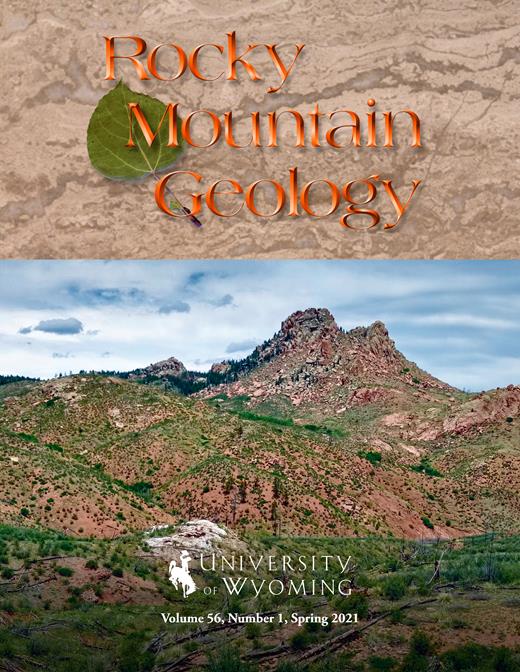Bulk composition of a zoned rare-earth minerals-bearing pegmatite in the Pikes Peak granite batholith near Wellington Lake, central Colorado, U.S.A.
| Reviews and Highlights | Quantum Science | Molecular and Soft-matter | Ultrafast Nano-optics and Nanophotonics | Mineralogy and Geochemistry |
|---|
Markus B. Raschke, Charles R. Stern, Evan J. D. Anderson, M. Alexandra Skewes, G. Lang Farmer, Julien M. Allaz, and Philip M. Persson
Rocky Mountain Geology 56, 1 (2021).
DOI PDF

A previously undescribed small lenticular (~5 × 5 × 5 m) pegmatite, located near Wellington Lake in the NW part of the 1.08 Ga ‘A-type’ (anorogenic) ferroan Pikes Peak granite batholith, ~15 km SW of the South Platte pegmatite district in central Colorado, is concentrically zoned around a mostly monomineralic quartz core with interconnected miarolitic cavities. Major constituents of the Wellington Lake pegmatite are quartz, perthitic microcline, albite (variety cleavelandite), hematite, and biotite. Accessory minerals include fluocerite, bastnäsite, columbite, zircon (var. ‘cyrtolite’), thorite, and secondary U phases. Fluorite is conspicuously absent, although it is a common phase in the South Platte district NYF-type pegmatites, which are rich in niobium (Nb), yttrium (Y), fluorine (F), and heavy rare-earth elements (HREE). Notable for the Wellington Lake pegmatite are a small quantity of well-developed tabular crystals of fluocerite that reach up to 4 cm in diameter, with sub-mm epitaxial bastnäsite overgrowths, suggesting formation from F- and CO2-bearing solutions rich in light rare-earth elements (LREE), with decreasing a(F-)/a(CO32-) during the last crystallization phase. An Nd-isotope value of εNd1.08Ga = -1.6 for the fluocerite is within the range of εNd1.08Ga = -0.2 to -2.7 of the host coarse-grained, pink K-series Pikes Peak Granite (PPG), indicating that REE and other pegmatite constituents derived from the parental PPG magma. A calculation of total pegmatite composition based on whole-rock chemistry and volume estimates of the different pegmatite zones reveals an overall composition similar to the PPG with respect to Si, Al, Na, and K. Yet the pegmatite is depleted in Fe, Mg, Ca, Ti, Mn, and P, the high-field-strength elements (HFSE; Zr, Hf, Nb, Y, Th), and, most significantly, total REE compared to the PPG. Despite containing the LREE minerals fluocerite and bastnäsite, the lack of a net overall REE enrichment of the pegmatite compared to the PPG reflects the large amount of REE-poor silicate minerals forming the wall, intermediate, and core zones of the pegmatite. The calculated total pegmatite composition suggests that the pegmatite formed by the separation from the PPG magma of an F-poor H2O-saturated silicate melt depleted in REE and HFSE compared to the F-rich melts, which formed the NYF-type HREE-rich (LaN/YbN < 1) pegmatites in the South Platte district. Homogenization temperatures of < 500°C for possibly primary fluid inclusions in large quartz crystals from the core of the Wellington Lake pegmatite are consistent with recent models of pegmatite petrogenesis leading to nucleation controlled mega-crystal growth resulting from supercooling.A previously undescribed small lenticular (~5 × 5 × 5 m) pegmatite, located near Wellington Lake in the NW part of the 1.08 Ga ‘A-type’ (anorogenic) ferroan Pikes Peak granite batholith, ~15 km SW of the South Platte pegmatite district in central Colorado, is concentrically zoned around a mostly monomineralic quartz core with interconnected miarolitic cavities. Major constituents of the Wellington Lake pegmatite are quartz, perthitic microcline, albite (variety cleavelandite), hematite, and biotite. Accessory minerals include fluocerite, bastnäsite, columbite, zircon (var. ‘cyrtolite’), thorite, and secondary U phases. Fluorite is conspicuously absent, although it is a common phase in the South Platte district NYF-type pegmatites, which are rich in niobium (Nb), yttrium (Y), fluorine (F), and heavy rare-earth elements (HREE). Notable for the Wellington Lake pegmatite are a small quantity of well-developed tabular crystals of fluocerite that reach up to 4 cm in diameter, with sub-mm epitaxial bastnäsite overgrowths, suggesting formation from F- and CO2-bearing solutions rich in light rare-earth elements (LREE), with decreasing a(F-)/a(CO32-) during the last crystallization phase. An Nd-isotope value of εNd1.08Ga = -1.6 for the fluocerite is within the range of εNd1.08Ga = -0.2 to -2.7 of the host coarse-grained, pink K-series Pikes Peak Granite (PPG), indicating that REE and other pegmatite constituents derived from the parental PPG magma. A calculation of total pegmatite composition based on whole-rock chemistry and volume estimates of the different pegmatite zones reveals an overall composition similar to the PPG with respect to Si, Al, Na, and K. Yet the pegmatite is depleted in Fe, Mg, Ca, Ti, Mn, and P, the high-field-strength elements (HFSE; Zr, Hf, Nb, Y, Th), and, most significantly, total REE compared to the PPG. Despite containing the LREE minerals fluocerite and bastnäsite, the lack of a net overall REE enrichment of the pegmatite compared to the PPG reflects the large amount of REE-poor silicate minerals forming the wall, intermediate, and core zones of the pegmatite. The calculated total pegmatite composition suggests that the pegmatite formed by the separation from the PPG magma of an F-poor H2O-saturated silicate melt depleted in REE and HFSE compared to the F-rich melts, which formed the NYF-type HREE-rich (LaN/YbN < 1) pegmatites in the South Platte district. Homogenization temperatures of < 500°C for possibly primary fluid inclusions in large quartz crystals from the core of the Wellington Lake pegmatite are consistent with recent models of pegmatite petrogenesis leading to nucleation controlled mega-crystal growth resulting from supercooling.
